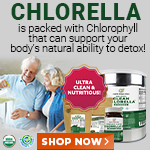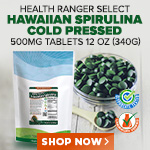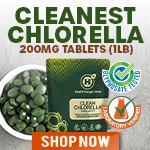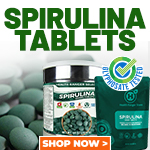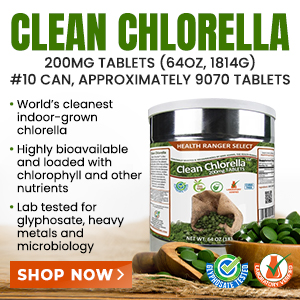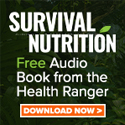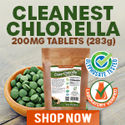
Live Naturally with Herbs: Healing Properties of Arnica
Friday, July 02, 2010 by: Katherine East
Tags: arnica, healing, health news
- Pfizer's RSV vaccine linked to preterm births as drug giant CONCEALED RISKS from pregnant women in unethical clinical trials
- Dane Wigington exposes climate engineering as ‘All-Out Weather and Biological Warfare’
- Sen. Johnson demands COVID vaccine makers hand over all documents, communications, as evidence against their products reaches a climax
- Photonic revolution: New chips process data using light instead of electricity
- Criminal referral requests filed against Fauci and top COVID officials in seven states
- EU pauses retaliatory tariffs as Trump temporarily halts new duties
- Israeli lobbyists boast of controlling US national security policy in leaked AIPAC audio
- The humble Potato: Nutritional benefits and how to enjoy it the healthy way
- Analysis: The coming economic collapse, a mass uprising and Trump's three secret weapons to halt the growing revolt
- Tulsi Gabbard leads charge against the Biden regime’s global censorship of the 'Disinformation Dozen'
- Aerosolized bioweapons? Strange “diploid biomasses” falling out of the sky in Florida captured under the microscope
- Aluminum, essential to vaccine science, also causes serious health conditions, including chronic fatigue, neurodegenerative diseases, macrophagic myofasciitis
- Fauci is back in the limelight, and he’s busy promoting a future COVID or FLU pandemic
- DOGE unveils $400M unemployment fraud scandal: Toddlers, futuristic birthdates fuel outcry
- Shedding light on the dark side of MMR vaccines: How vaccinated individuals SPREAD MEASLES & put the vulnerable at risk
- Chemtrails unveiled: How the CIA and Big Business are manipulating the weather for profit
- U.S. lawmakers investigate Meta over alleged China collaboration
- Kiss Your Genetic Privacy Good-Bye! 23andMe Gets Green Light to Sell Your Intimate Genetic Details to Anyone They Want
- Aerosolized bioweapons? Strange “diploid biomasses” falling out of the sky in Florida captured under the microscope
- Widespread social and economic unrest: Steve Quayle issues urgent financial warning of imminent asset collapse in new interview with Mike Adams
- Tulsi Gabbard leads charge against the Biden regime’s global censorship of the 'Disinformation Dozen'
- Fauci is back in the limelight, and he’s busy promoting a future COVID or FLU pandemic
- Analysis: The coming economic collapse, a mass uprising and Trump's three secret weapons to halt the growing revolt
- Kiss Your Genetic Privacy Good-Bye! 23andMe Gets Green Light to Sell Your Intimate Genetic Details to Anyone They Want
- CLOT SHOT PLANDEMIC UNFOLDING: Fibrous, rubbery clots caused by covid injections have prion-like seeding activity
- Mike Adams releases country western hit single: Goin’ Back in Time is Comin’ Home
- DEATH by VACCINE or face PRISON time: Canadian Freedom Convoy leaders CONVICTED for protesting forced vaccination during the Covid Plandemic
- Tulsi Gabbard takes aim at censorship: Justice for the ‘Disinformation Dozen’
- How Israeli military-connected corporations are secretly controlling your online privacy
- European Court of Justice: Healthcare professionals who promoted or administered COVID-19 vaccines are CRIMINALLY LIABLE for any harm caused
- Defunding DEADLY mRNA jabs: Government funding for mRNA technology being scrutinized and sidelined until proven "safe and effective" for real
- U.S. lawmakers investigate Meta over alleged China collaboration
- Federal employees whine over DOGE's new directive requiring them to do a 5-point summary of weekly accomplishments
- U.S. approves new Russian ambassador as diplomatic thaw continues
- Trump administration poised to overhaul crypto regulations with new SEC leadership
- I Want My Bailout Money – new song and music video released by Mike Adams
- Newly released JFK files reveal Pentagon's role in creating Lyme disease and covid in the same lab
- Analysis: The coming economic collapse, a mass uprising and Trump's three secret weapons to halt the growing revolt
- Mike Adams releases country western hit single: Goin’ Back in Time is Comin’ Home
- MEDICAL BOMBSHELL: FDA admits Covid mRNA 'Vaccines' CAUSE CANCER
- Aerosolized bioweapons? Strange “diploid biomasses” falling out of the sky in Florida captured under the microscope
- Trump reverses course on Gaza plan, says “nobody is expelling Palestinians”
- Dr. Mike Yeadon releases 15-minute testimony - WATCH - about genocidal intent of COVID “vaccines”
- Kiss Your Genetic Privacy Good-Bye! 23andMe Gets Green Light to Sell Your Intimate Genetic Details to Anyone They Want
- 5 Simple steps to boost your brainpower: How to strengthen executive function in a distracted world
- A lack of integrity in Academia: Harvard professor found GUILTY of fraudulent research to promote CRT theory
- The Health Ranger releases “Vaccine Zombie” song and music video, using AI-animated zombies for the music video
- California's social media censorship law struck down: A victory for free speech or a threat to online safety?
- Rep. Nancy Mace introduces bill to ban biological males from female facilities on federal property
- EPA advisor admits the agency is funneling billions to climate groups ahead of Trump’s return to White House
- Survival 101: Effective EMF blocking techniques
- OpenAI whistleblower who dissented against how the company trained ChatGPT found dead
- Space war brewing? Russia threatens to destroy Starlink satellites
- European Court of Justice: Healthcare professionals who promoted or administered COVID-19 vaccines are CRIMINALLY LIABLE for any harm caused
- Red Cross issues warning to stop blood plasma donations from vaccinated people
- Scientists confirm: GENIUS brain function can be spontaneously unleashed in humans without any apparent cause
- EPA advisor admits the agency is funneling billions to climate groups ahead of Trump’s return to White House
- HYSSOP: What research reveals about the health benefits of this ancient holy herb
- Two containers with completed ballots fall out of truck in Florida
- Newly released JFK files reveal Pentagon's role in creating Lyme disease and covid in the same lab
- Global leaders unite to clamp down on “misinformation” with UN-backed Cascais Declaration
- Fully vaccinated about to see “tsunami” of illness and death, warns virologist
- BREAKING: 2025 NDAA authorizes mandatory military draft of WOMEN across America… as Pentagon pursues global NUCLEAR war with both Russia and China at the same time
- Michael Yon warns of a ZIONIST TAKEOVER in Trump’s second administration
- Ozempic and Wegovy weight loss drugs are injectable LIZARD VENOM PEPTIDES that may unleash a devastating wave of organ failure… side effects align with symptoms of SNAKE BITES
- The Health Ranger releases “Vaccine Zombie” song and music video, using AI-animated zombies for the music video
- BOMBSHELL: DNA testing kits are a SCAM to develop ethnic-specific bioweapons
- Mike Adams releases country western hit single: Goin’ Back in Time is Comin’ Home
- Israeli soldiers accused of even more torture and abuse in the West Bank
- These 13 countries just signed an agreement to engineer a global FAMINE by destroying food supply
- NASA admits that climate change occurs because of changes in Earth’s solar orbit, and NOT because of SUVs and fossil fuels
- RFK Jr. clears key hurdle: Sen. Susan Collins backs controversial HHS nominee, signaling a new era for health policy
Arnica is well-known for treating injuries and bruises and it's an excellent remedy to have in your first-aid kit or sports kit bag. Well-known in traditional medicine, it is often the first remedy to be given after a fall, muscle strain, injury or surgery. Arnica has also been used as a tobacco substitute and another of its names is mountain tobacco, or "smokeherb".
Therapeutic Action
For medicinal purposes Arnica tincture is made from the whole fresh plant including the root. It is commonly used in the form of topical creams, gels and ointments or homeopathic pillules.
When applied directly after an injury Arnica significantly reduces bruise formation. It is also helpful for treating arthritis, burns, ulcers, eczema, and acne. Anti-bacterial and anti-inflammatory qualities help reduce pain and swelling while improving wound healing.
Arnica contains sesquiterpene lactones (known to reduce inflammation and decrease pain), the volatile oil thymol, arnicin, arnisterol (arnidiol), flavonoids such as anthoxanthine, tannin, resin, a polysaccharide inulin, mucilage and manganese. Inulin passes unabsorbed through the digestive system, remaining neutral to cellular activity, and is often used to sweeten food consumed by diabetic patients. Inulin has antidiabetic, gastrostimulant, hypoglycaemic, immunostimulant, lypolytic and probiotic action. It's the sesquiterpene lactones that reduce inflammation by dispersing fluids that build up in bruised and injured tissue. Arnica helps to mop up inflammatory debris and lactic acid, which reduces swelling and relieves pain after injury and muscle strain.
Common clinical external uses for Arnica include:
- bruising
- black eye
- septic conditions such as painful recurrent boils
- muscle exhaustion from over-exertion (wonderful for a muscle rub)
- altitude sickness
- injuries, i.e. falls, sprains, blows, bruises and fractures
- after surgery
- sprains
- painful joints
Arnica For Labour
Arnica has been popularly used as a homeopathic remedy for relieving bruising and speeding up healing after childbirth. It is usually given at the beginning of labour to help muscles function effectively and to prepare the body for the strain of labour and childbirth. For postnatal treatment of episiotomy stitches or tears, many midwives recommend that Arnica oil be added to a bath or a jug of water poured over the area to speed up healing.
Caution When Using Arnica
Arnica is generally safe when taken externally. The cream or tincture should not be used externally on broken skin as it may cause irritation. Avoid the topical forms if you have an allergy to Arnica or to related daisy plants such as Chamomile or Marigolds. While not dangerous, it can cause a rash or itching.
Arnica contains the toxin helenalin, and it should only be used internally under the supervision of a health-care provider and then only in a homeopathic form. Ingesting the herb directly may cause tremors, dizziness, vomiting and heart problems.
Large doses produce a transient excitement, followed by depressed circulation, respiration and temperature; a violent headache; dilated pupils and muscular paresis. A toxic dose paralyses the nervous system, causing collapse and even death.
Similarly, Arnica is excellent for hemorrhagic tendencies but should not be used in patients who are on blood-thinning medication, as this may increase the likelihood of bleeding.
References:
http://www.nutrasanus.com/arnica.html
http://www.mamawell.com/mamawell/2007/02/won...
Illustrated Book Of Herbs - New Holland Publishers LTD
Gottlieb, Bill.
About the author
Katherine Oosthuis is completing a Diploma in Nutritional Therapy. She researches and writes for a health and nutrition website Detox For Life . Her passion is to make research available to those who are looking to improve their well-being and revolutionise their health through better nutrition and alternative medicines.Arnica at FETCH.news
Get independent news alerts on natural cures, food lab tests, cannabis medicine, science, robotics, drones, privacy and more.
Take Action: Support Natural News by linking to this article from your website
Permalink to this article:
Embed article link: (copy HTML code below):
Reprinting this article:
Non-commercial use OK, cite NaturalNews.com with clickable link.
Follow Natural News on Facebook, Twitter, Google Plus, and Pinterest
Science News & Studies
Medicine News and Information
Food News & Studies
Health News & Studies
Herbs News & Information
Pollution News & Studies
Cancer News & Studies
Climate News & Studies
Survival News & Information
Gear News & Information
News covering technology, stocks, hackers, and more



"Big Tech and mainstream media are constantly trying to silence the independent voices that dare to bring you the truth about toxic food ingredients, dangerous medications and the failed, fraudulent science of the profit-driven medical establishment.
Email is one of the best ways to make sure you stay informed, without the censorship of the tech giants (Google, Apple, Facebook, Twitter, YouTube, etc.). Stay informed and you'll even likely learn information that may help save your own life."
–The Health Ranger, Mike Adams













